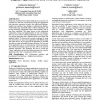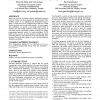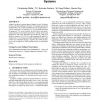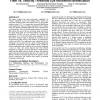EICS
2009
ACM
14 years 4 months ago
2009
ACM
The success of service-oriented computing has important implications on how people develop user interfaces. This paper discusses a method for supporting the development of interac...
EICS
2009
ACM
14 years 6 months ago
2009
ACM
In this paper we present a software toolkit for deploying peer-topeer distributed graphical user interfaces across four dimensions: multiple displays, multiple platforms, multiple...
EICS
2009
ACM
14 years 6 months ago
2009
ACM
Single-user, desktop-based computer applications are pervasive in our daily lives and work. The prospect of using these applications with innovative interaction systems, like mult...
EICS
2009
ACM
14 years 6 months ago
2009
ACM
Many tools exist for developing real-time distributed groupware, but most of these tools focus primarily on the performance of the resulting system, or on simplifying the developm...
EICS
2009
ACM
14 years 6 months ago
2009
ACM
Adaptive groupware systems support changes in users’ locations, devices, roles and collaborative structure. Developing such systems is difficult due to the complex distributed ...
EICS
2009
ACM
14 years 6 months ago
2009
ACM
Usage data logged from user interactions can be extremely valuable for evaluating software usability. However, instrumenting software to collect usage data is a time-intensive tas...
EICS
2009
ACM
14 years 6 months ago
2009
ACM
This paper evaluates the input performance capabilities of Velocity Threshold (I-VT) and Kalman Filter (I-KF) eye movement detection models when employed for eye-gaze-guided inter...
EICS
2009
ACM
14 years 6 months ago
2009
ACM
Discovering and unlocking the full potential of complex pervasive environments is still approached in application-centric ways. A set of statically deployed applications often de�...
EICS
2009
ACM
14 years 6 months ago
2009
ACM
Interactive computing systems frequently use pointing as an input modality, while also supporting other forms of input such as alphanumeric, voice, gesture, and force. We focus on...
EICS
2009
ACM
14 years 6 months ago
2009
ACM





